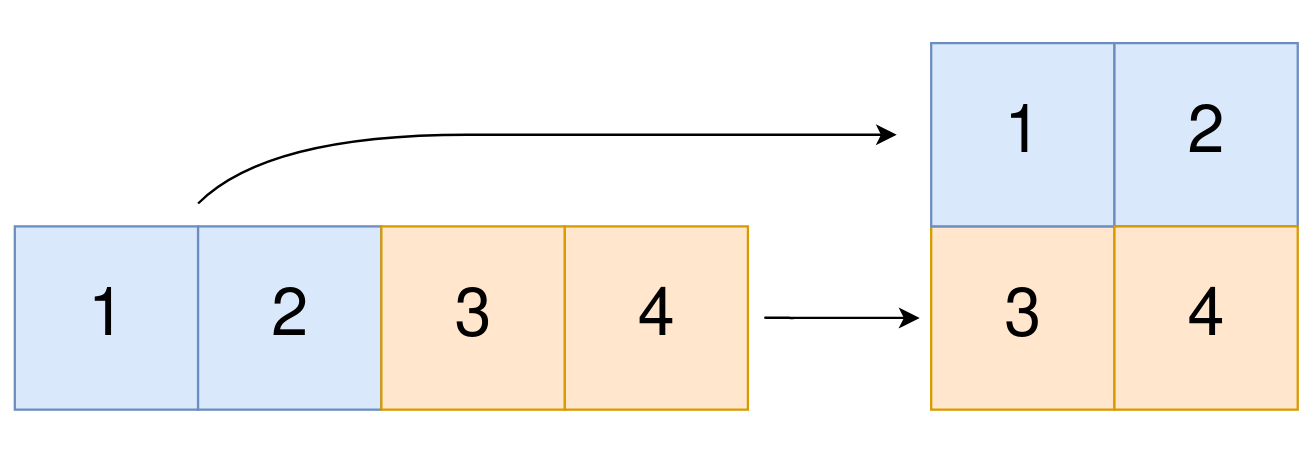Welcome to Subscribe On Youtube
2022. Convert 1D Array Into 2D Array
Description
You are given a 0-indexed 1-dimensional (1D) integer array original, and two integers, m and n. You are tasked with creating a 2-dimensional (2D) array with m rows and n columns using all the elements from original.
The elements from indices 0 to n - 1 (inclusive) of original should form the first row of the constructed 2D array, the elements from indices n to 2 * n - 1 (inclusive) should form the second row of the constructed 2D array, and so on.
Return an m x n 2D array constructed according to the above procedure, or an empty 2D array if it is impossible.
Example 1:

Input: original = [1,2,3,4], m = 2, n = 2 Output: [[1,2],[3,4]] Explanation: The constructed 2D array should contain 2 rows and 2 columns. The first group of n=2 elements in original, [1,2], becomes the first row in the constructed 2D array. The second group of n=2 elements in original, [3,4], becomes the second row in the constructed 2D array.
Example 2:
Input: original = [1,2,3], m = 1, n = 3 Output: [[1,2,3]] Explanation: The constructed 2D array should contain 1 row and 3 columns. Put all three elements in original into the first row of the constructed 2D array.
Example 3:
Input: original = [1,2], m = 1, n = 1 Output: [] Explanation: There are 2 elements in original. It is impossible to fit 2 elements in a 1x1 2D array, so return an empty 2D array.
Constraints:
1 <= original.length <= 5 * 1041 <= original[i] <= 1051 <= m, n <= 4 * 104
Solutions
Solution 1: Simulation
According to the problem description, we know that to construct an $m$-row and $n$-column two-dimensional array, it needs to satisfy that $m \times n$ equals the length of the original array. If it does not satisfy, return an empty array directly.
If it does satisfy, we can follow the process described in the problem, and put the elements from the original array into the two-dimensional array in order.
The time complexity is $O(m \times n)$, where $m$ and $n$ are the number of rows and columns of the two-dimensional array, respectively. Ignoring the space consumption of the answer, the space complexity is $O(1)$.
-
class Solution { public int[][] construct2DArray(int[] original, int m, int n) { if (m * n != original.length) { return new int[0][0]; } int[][] ans = new int[m][n]; for (int i = 0; i < m; ++i) { for (int j = 0; j < n; ++j) { ans[i][j] = original[i * n + j]; } } return ans; } } -
class Solution { public: vector<vector<int>> construct2DArray(vector<int>& original, int m, int n) { if (m * n != original.size()) { return {}; } vector<vector<int>> ans(m, vector<int>(n)); for (int i = 0; i < m; ++i) { for (int j = 0; j < n; ++j) { ans[i][j] = original[i * n + j]; } } return ans; } }; -
class Solution: def construct2DArray(self, original: List[int], m: int, n: int) -> List[List[int]]: if m * n != len(original): return [] return [original[i : i + n] for i in range(0, m * n, n)] -
func construct2DArray(original []int, m int, n int) (ans [][]int) { if m*n != len(original) { return [][]int{} } for i := 0; i < m*n; i += n { ans = append(ans, original[i:i+n]) } return } -
function construct2DArray(original: number[], m: number, n: number): number[][] { if (m * n != original.length) { return []; } const ans: number[][] = []; for (let i = 0; i < m * n; i += n) { ans.push(original.slice(i, i + n)); } return ans; } -
/** * @param {number[]} original * @param {number} m * @param {number} n * @return {number[][]} */ var construct2DArray = function (original, m, n) { if (m * n != original.length) { return []; } const ans = []; for (let i = 0; i < m * n; i += n) { ans.push(original.slice(i, i + n)); } return ans; };